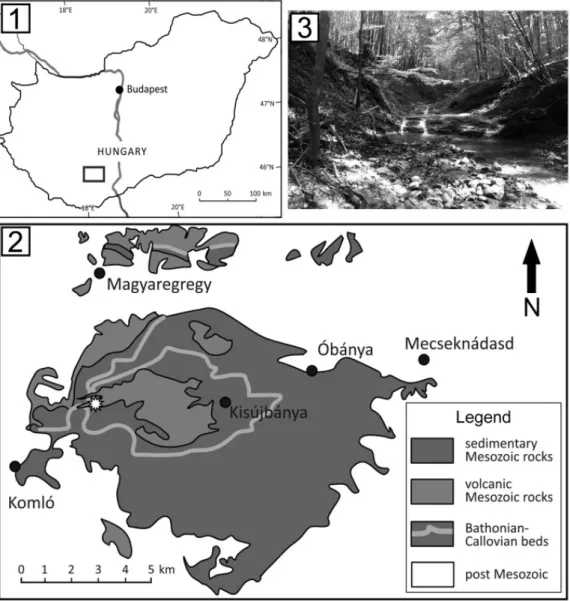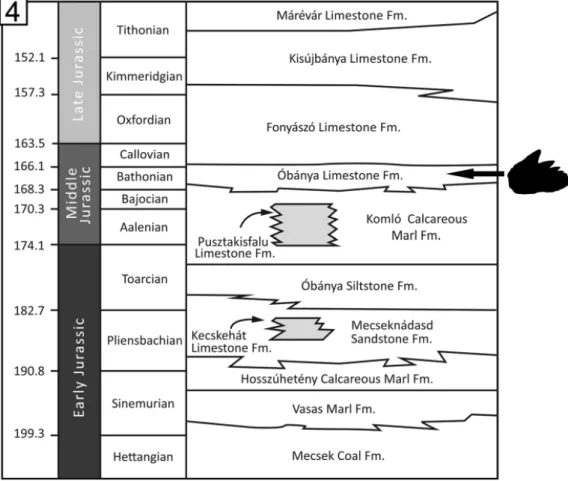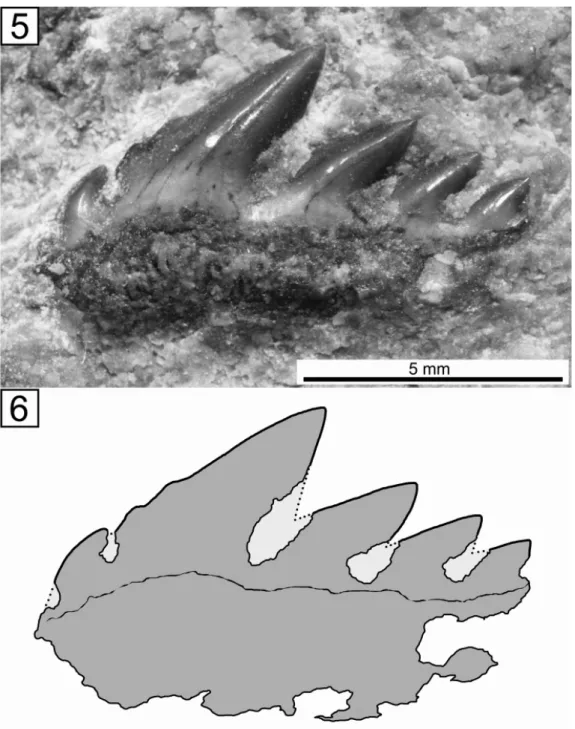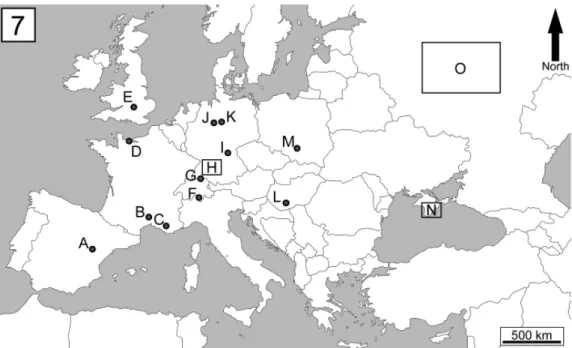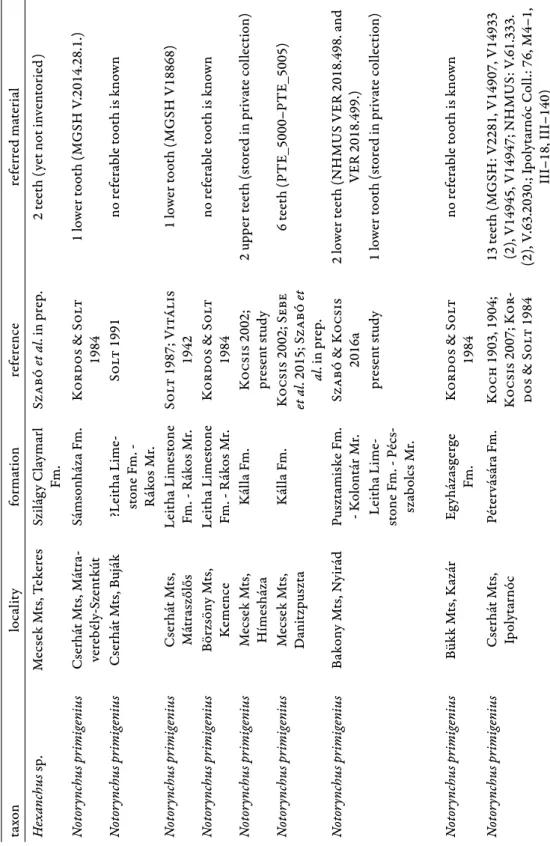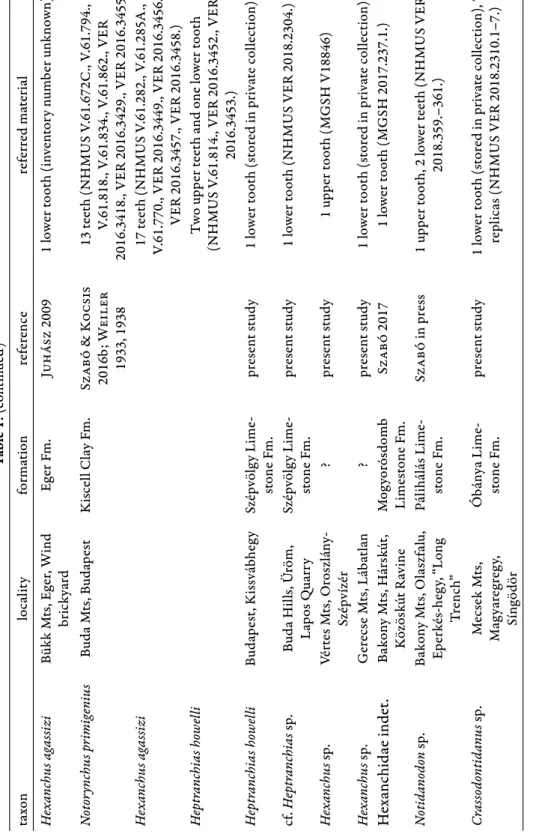Volume 35 Budapest, 2018 pp. 87–102
First record of the hexanchoid shark genus Crassodontidanus (Chondrichthyes: Hexanchiformes) from the Jurassic of Hungary
(Mecsek Mts, Southern Hungary),
with a summary of the hexanchiform fossil record of Hungary
Márton Szabó1, 2
1Department of Palaeontology, Eötvös Loránd University, H-1117 Budapest, Pázmány Péter sétány 1/C, Hungary;
2Department of Palaeontology and Geology, Hungarian Natural History Museum, H-1083 Budapest, Ludovika tér 2, Hungary. E-mail: szabo.marton.pisces@gmail.com
Abstract – Th e fi rst occurrence of Crassodontidanidae of Hungary is described. Th e material con- sists of a single tooth, currently placed in private collection. Th e specimen was found nearby Ma- gyaregregy, at the so-called Síngödör outcrop, in the Middle Jurassic (Bathonian) Óbánya Lime- stone Formation. Th e tooth is characterized by a serrated mesial cutting edge of the main cusp, high root with convex mesial and distal margins. Th is character combination readily distinguishes the tooth from those of Hexanchidae. Currently, this is the oldest representation of Hexanchiformes in the fossil record of Hungary, which widens our knowledge on the distribution patterns of Crasso- dontidanidae. Summarized data of the hexanchiform fossil record of Hungary is also detailed here.
Th e data show the presence of 3 families (Crassodontidanidae, Hexanchidae, Heptranchidae) with 5 genera (Crassodontidanus, Notidanodon, Hexanchus, Notorynchus and Heptranchias) from the Ba- thonian (Jurassic) to the Badenian (Miocene). With 22 fi gures and 1 table.
Key words – Bathonian, Crassodontidanidae, Crassodontidanus, Hexanchiformes, Magyaregregy
INTRODUCTION
Hexanchiformes is a monophyletic group of plesiomorphic squalomorph neoselachians, with a fossil record extending back into to the Jurassic (Kriwet
& Klug 2011). Th eir fossil record is dominated by isolated teeth; however, ar- ticulated skeletons are also known (Kriwet & Klug 2004, 2011, 2014). Th e order has 7 extant species, representing two suborders with three families (Chla- mydoselachidae: Chlamydoselachus (2); Hexanchidae: Hexanchus (3), Notoryn- chus (1); Heptranchidae: Heptranchias (1) (Pollerspöck & Straube 2018).
Crassodontidanidae Kriwet et Klug 2016 was fi rst described by Kriwet &
Klug (2011), as Crassonotidae. Th e family is currently grouped into the sub order Hexanchoidei, together with Hexanchidae and Heptranchidae. Crassodontida-
nidae is the most plesiomorphic family within the order Hexanchiformes, rang- ing from the Sinemurian (Early Jurassic) to the Hauterivian (Early Cretaceous) and including three genera: Crassodontidanus, Notidanoides and Pachyhexanchus (Kriwet & Klug 2011). Crassonotidanids had their greatest taxonomic diver- sity in the Jurassic (Kriwet & Klug 2011).
Th e Mesozoic occurrence of Hexanchiformes in Hungary is sporadic. Up to now, Mesozoic hexanchiforms are known only from two localities of Hungary:
the Valanginian Mogyorósdomb Limestone Formation nearby Hárskút (Hexan- chi dae indet.; Szabó 2017), and the Kimmeridgian–Tithonian Pálihálás Lime- stone Formation nearby Olaszfalu (Notidanodon sp., Hexanchidae; Szabó in press).
Th e present study describes the oldest currently known hexanchoid hex- anchiform fossil of Hungary, found in the Mecsek Mts (Southern Hungary), and summarizes the hexanchiform fossil record of the country.
GEOLOGICAL SETTING
Th e locality lies in the eastern part of the Mecsek Mts (Southern Hungary), south from the village of Magyaregregy (Figs 1, 2). Th e Síngödör is an east-west side valley, situated south from the Márévár Valley, in the main valley running from Magyaregregy to Zobákpuszta, also running down easterly from the hills bordering the Kisújbánya syncline (Figs 2, 3). Upper Jurassic then Bajocian beds are exposed in the western end of this valley. Along the folded sequence, outcrops become poor- er toward the clayey marls of the Upper Bajocian. Th e Bathonian outcrop is rather poor, exposing only a few beds in a slightly domed structure. In the low cuts of the stream, this is followed by reddish calcareous marls and nodular limestones, rep- resented by the typically red or variegated, nodular Óbánya Limestone Formation (Galácz 1994, 2012) (Fig. 4). Th e hexanchiform tooth detailed in the present study was collected from this formation (L. Sövér, pers. comm.).
Th e Óbánya Limestone Formation is a 10–20 m thick formation, a so-called
„ammonitico-rosso” facies, characteristic for the Tethyan Province (Price et al.
2018; Császár et al. 2013). Kovács (1953, p. 91) gave a short list of ammo- nites unearthed here with the conclusion that the collected ammonites indicate a mainly Bathonian age for the limestone, while Early Callovian is also represent- ed. Later on, Galácz (1994, 2012) re-visited the outcrops, and a usual ammo- nite faunula was collected. Galácz also re-investigated the collected specimens of Kovács, and concluded that (on the basis of all the hitherto known fossils) the investigated red nodular Middle Jurassic limestone of the Mecsek Mts represents the Bathonian only.
Belemnites, brachiopods, and bivalves also occur in the formation. Based on the investigation of the microfaunal elements (foraminifers and ostracods), the sediment was deposited in an off -shore, medium to deep bathyal environ- ment with relatively poor nutrient supply (Császár et al. 2013). In the present days, the Síngödör outcrops are poor and overgrown, and although the charac- teristic rock is easy to identify, a bed-by-bed collecting cannot be carried out (Galácz 1994).
Fig. 1. Location map of the Óbánya Valley within Hungary (modifi ed aft er Price et al. 2018). – Fig. 2. Distribution of Mesozoic sedimentary and volcanic units within the Mecsek Mts (modifi ed aft er Price et al. 2018 and Galácz 1994). – Fig. 3. Th e Síngödör site in 2016 (photo courtesy of
Csaba Papp)
MATERIAL AND METHODS
Th e Magyaregregy tooth specimen detailed in the present study is stored in the private collection of László Sövér (Bonyhád-Majos), who found the tooth on the 4th of July, in 1993. Seven replicas were made aft er the original tooth. Protesil Putty was used for making the negative, while the replicas themselves were made of Acrystal Prima acrylic resin. All replicas are housed in the vertebrate fossil col- lection of the Hungarian Natural History Museum, Budapest.
Tooth anatomical terminology for describing the Magyaregregy hexanchi- form tooth follows the work of Cappetta (2012) and Kriwet & Klug (2011).
For measuring tooth dimensions ImageJ soft ware (version 1.48) was used.
For summarizing the hexanchiform fossil record an exhaustive search has been carried out both in literature, and in museum and private collections.
Institutional abbreviations used in the text: MGSH = Mining and Geological
Fig. 4. Lithostratigraphical scheme for the Jurassic deposits of the Mecsek Zone (Southern Hun- gary) (modifi ed aft er Price et al. 2018) and stratigraphical position of the studied tooth
Survey of Hungary, NHMUS = Hungarian Natural History Museum, PTE = University of Pécs. In some cases hexanchiform teeth are only mentioned in ref- erences, but referable tooth fossils stored in any museum (or private) collections of Hungary, are unknown.
SYSTEMATIC PALAEONTOLOGY Superclass Chondrichthyes Huxley, 1880
Cohort Euselachii Hay, 1902 Subcohort Neoselachii Compagno, 1977
Order Hexanchiformes De Buen, 1926 Suborder Hexanchoidei Garman, 1913 Family Crassodontidanidae Kriwet et Klug, 2016
Genus Crassodontidanus Kriwet et Klug, 2011 Crassodontidanus sp.
(Figs 5, 6)
Referred material: 1 lower lateral tooth (stored in L. Sövér private collec- tion); 7 replicas (NHMUS VER 2018.2310.1–7.).
Description – Th e tooth is 9.6 mm of mesiodistal length, and 6 mm of api- cobasal height. It is still embedded in a piece of stone-matrix, in which it is dis- played in lingual aspect. Th e mesial cutting edge of the main cusp is serrated, no well-marked mesial cusplets are present. Th e main cusp is distally inclined, massive and stout. Th e apical half of the mesial cutting edge is slightly convex, while the distal cutting edge of the main cusp is straight. Th ree distally inclined distal cusplets, decreasing gradually in size distally, are preserved. Th e neck of the tooth crown is well-developed, the root is high, possessing a convex outline.
Remains of the lingual root bulge are visible; however, the lingual root face is poorly preserved. Th e basal root face is broad, the preserved root-portions refer to a slightly convex mesial and distal outline.
Taxonomic assignment – Following Cappetta (2012), the Magyaregregy hexanchiform lower tooth shows typical hexanchoid morphology by being strongly labiolingually fl attened, and by being characterized by a crown with a main cusp followed by a series of distal cusplets („accessory cusps” by Cappetta 2012) decreasing distally in size. Isolated tooth remains of hexanchoid families are mainly distinguishable by the dental characteristics of the lower teeth.
Hexanchidae and Heptranchidae expose dental characters diff erent from those of the Magyaregregy specimen. Hexanchidae possess multicuspid lower teeth with rectangular root strongly compressed labiolingually with the ba- sal root face being almost vertical (Kriwet & Klug 2011), conversely to the
Fig. 5. Crassodontidanus sp. lower tooth from the Bathonian (Middle Jurassic) Óbánya Limestone Formation of the Síngödör (nearby Magyaregregy, Mecsek Mts, Southern Hungary), in lingual as-
pect. – Fig. 6. Line drawing of the same view
Magyaregregy hexanchoid tooth. In Heptranchidae and some Hexanchidae, the mesial serrations form well marked mesial cusplets. An important character of lower heptranchid teeth is that the size of distal cusplets decreases irregularly to the distal edge of the tooth (Cappetta 2012). Th is diff ers in the Magyaregregy tooth, which bears distal cusplets regularly decreasing in size distally.
Th e third (and last) hexanchoid family Crassodontidanidae includes Crassodontidanus, Notidanoides, and Pachyhexanchus. Th e generic description of the Magyaregregy tooth is challenging. Kriwet & Klug (2011) listed the fol- lowing dental characters for the crassodontidanid Crassodontidanus: 1 – the up- per and mesial teeth are multicuspid; 2 – only weak dignathic and monognathic heterodonties are present; 3 – the mesial cutting edge of main cusp is serrated; 4 – no mesial cusplets are present; 5 – the main cusp is stout and massive; 6 – up to seven accessory cusplets, decreasing gradually in size distally are present; 7 – the crown neck is well-developed; 8 – the root is thick and high with convex outline in labial and lingual views; 9 – a prominent lingual root bulge is present; 10 – the basal root face is oblique in profi le views forming an acute angle; 11 – the basal root face is broad and slightly convex. Among the listed characters, 3, 4, 5, 6, 7, 8, 9, and 11 are visible on the Magyaregregy specimen.
Character 3 seems to be an important character, because serrated mesial cut- ting edge of the main cusp is present only in Crassodontidanus among all crasso- dontidanids (Kriwet & Klug 2011). Th is genus ranges from the Pliensbachain to the Kimmeridgian (Kriwet & Klug 2011), covering the Bathonian age of the Magyaregregy crassodontidanid.
To sum up, the preserved dental characteristics clearly assign the Magyareg- regy tooth to Crassodontidanus, member of family Crassodontidanidae. Crasso- dontidanus currently includes two species, C. serratus and C. wiedenrothi, but since the Magyaregregy tooth is an isolated specimen, a specifi c assignment would not be established.
DISTRIBUTIONAL PATTERNS OF CRASSODONTIDANIDAE Th e family ranges from the Sinemurian (Notidanoides muensteri, original- ly as Notidanus arzoensis from the Sinemurian of Switzerland; De Beaumont 1960) to the Lower Cretaceous (Pachyhexanchus pockrandti from the Hauterivian of Northern Germany; Ward & Thies 1987). Geographically, the family shows a simple distributional pattern: only European reports are known. Th is includes Spain, France, England, Germany, Switzerland, Poland, Hungary, Crimea, and numerous localities in Western Russia (Furic 2016; Guinot et al. 2014;
Kriwet & Klug 2011, 2014 and references therein; Rees 2010; Trikolidi 2014; Fig. 7). Until the present study, the Carpathian Basin was a blind spot in
the crassodontidanid record of Europe, most likely by the undersampled Jurassic marine sediments, in looking aft er chondrichthyan remains.
THE HEXANCHIFORM FOSSIL RECORD OF HUNGARY
Order Hexanchiformes is represented in the vertebrate fossil record of Hungary by suborder Hexanchoidei with 3 families: Crassodontidanidae, Hexanchidae, and
Fig. 7. Geographical distribution of Crassodontidanidae. – A = North-Eastern Spain, Moscardon (Upper Jurassic). – B = Southern France, La Cadière-et-Cambo (Lower Cretaceous). – C = Southern France, Rians (Upper Jurassic). – D = France, Normandy, Calvados (Middle to Upper Jurassic). – E = England, Oxford (Upper Jurassic). – F = Switzerland, Canton Ticino (Lower Jurassic). – G = Switzer- land, Canton Schaffh ausen (Upper Jurassic). – H = Fossil sites of Southern Germany (Baden-Würt- temberg: Gingen an der Fils, Glems, Lauchleim, Mahlstetten, Nusplingen, Schnaitheim, Lochen, Stu- ifen [all Upper Jurassic]; Bavaria: Daiting, Eichstätt, Solnhofen [all Upper Jurassic]). – I = Southern Germany, Franconian Alb, Streitberg (Late Jurassic). – J = Northern Germany, Engelbostel (Lower Cretaceous). – K = Northern Germany, Gretenberg near Hanover (Lower Jurassic). – L = South- ern Hungary, Mecsek Mts, Magyaregregy (Middle Jurassic). – M = Southern Poland, Orgodzieniec (Middle to Upper Jurassic). – N = Fossil sites of Crimea (Bolshoy Kermen Mountain [Lower Cre- taceous] and Belaya Mountain [Upper Cretaceous]). – O = Russia, several localities in the Moscow Basin (Lopatinsky Phosphorite Mine, Egorievsk Mine, basin of the Nara River, banks of the Moskva River at Mnevniki Village, Dyad’kovo, Kolomna, Tyrnovo, Mikhalenino [all Upper Jurassic]). – Aft er Furic 2016; Guinot et al. 2014; Kriwet & Klug 2011, 2014 and references therein; Rees 2010;
Trikolidi 2014. Some Russian occurrences are based on yet unpublished teeth, photography avail- able at http://naturephoto.ru/Fossils/s-9038.htm. Th e map does not show questionable or unsure
reports (e.g. “?Notidanoides sp.” in Underwood & Ward 2004)
Heptranchidae (see Table 1). Apart from detailed and/or illustrated reports of vari- ous hexanchiform taxa occurring in the fossil record of Hungary, a few incomplete or new reports are detailed below. For museum or private collection specimens available for a non-illustrated or new reports, see Figs 8–22.
Eocene – A lower hexanchiform tooth, housed in the private collection of Mihály Dunai, was found at an Eocene outcrop nerby Lábatlan (Gerecse Mts, Northern Hungary) (Figs 8, 9). Th e tooth is still embedded in a piece of stone- matrix, in which it lies in lingual aspect. Th e tooth has a distally inclined main cusp, followed by 8 distal cusplets, gradually decreasing in size. Th e root has a rectangular outline with a broad and straight basal margin. Th e mesial cutting edge is still covered by sediment. Based on the preserved and visible dental char- acters, this tooth is attributed to Hexanchus.
One upper hexanchiform tooth, unearthed from the Middle Eocene of Oroszlány-Szépvízér (Vértes Mts, North-Western Hungary), is housed in the ver- tebrate fossil collection of the MGSH (Figs 10, 11). It has one slightly sigmoid, slender main cusp, fl anked by two mesial and one distal cusplets. Th e root is rec- tangular in labial and lingual views, reaching its maximal thickness just below the crown base. Th e general tooth characteristics refer the tooth to Hexanchus.
Th e Upper Eocene (Priabonian) Szépvölgy Limestone Formation of the Lapos Quarry (Üröm, Buda Hills) yielded a fragmentary hexanchiform tooth (NHMUS VER 2018.2304.; Fig. 12). Th e tooth was found by Tamás Németh, and it is currently stored in the vertebrate fossil collection of the NHMUS. Th e main cusp and the preserved fi rst distal cusplet (similar to the main cusp but api- cobasally lower) are more upright than teeth of Hexanchidae, the well-marked mesial cusplets (4 in number) distally increasing in size. Th e section of the mesial cusplets is arched. Th e crown neck is horizontal, almost the whole root is miss- ing. Th e preserved characters refer the tooth with close relation to Heptranchias, which is widely distributed in the Eocene.
Th e Szépvölgy Limestone Formation is exposed in the Martinovits Quarry (Kissvábhegy, Budapest) as well. One lower tooth of Heptranchias howelli, placed in the private collection of Adam Anderson, is known from here (Fig. 13). Th e tooth is embedded in a piece of limestone, in lingual aspect. Th e size of distal cusplets decreases irregularly distally (with the last 1–2 distal cusplets suddenly decreasing in height). Th e root is fl at, low and rectangular.
Miocene – Vast majority of the hexanchiform record of Hungary comes from the Miocene. Th e Middle Miocene (Badenian) fossil site of Nyirád exposes two fossiliferous formations for fossil vertebrates: the Kolontár Member of the Pusztamiske Formation, and the Pécsszabolcs Member of the Leitha Limestone Formation (Szabó & Kocsis 2016a). Notorynchus primigenius is known from the Pusztamiske Formation since 2016, but recently a fragmentary lower tooth
Table 1: Summary of the hexanchiform fossil record of Hungary taxonlocalityformationreferencereferred material Hexanchus sp.Mecsek Mts, TekeresSzilágy Clay marl Fm.Szabó et al. in prep.2 teeth (yet not inventoried) Notorynchus primigeniusCserhát Mts, Mátra- verebély-SzentkútSámsonháza Fm.Kordos & Solt 19841 lower tooth (MGSH V.2014.28.1.) Notorynchus primigeniusCserhát Mts, Buják?Leitha Lime- stone Fm. - Rákos Mr.
Solt 1991no referable tooth is known Notorynchus primigeniusCserhát Mts, MátraszőlősLeitha Lime stone Fm. - Rákos Mr.Solt 1987; Vitális 19421 lower tooth (MGSH V18868) Notorynchus primigeniusBörzsöny Mts, KemenceLeitha Lime stone Fm. - Rákos Mr.Kordos & Solt 1984no referable tooth is known Notorynchus primigeniusMecsek Mts, HímesházaKálla Fm.Kocsis 2002; present study2 upper teeth (stored in private collection) Notorynchus primigeniusMecsek Mts, DanitzpusztaKálla Fm.Kocsis 2002; Sebe et al. 2015; Szabó et al. in prep.
6 teeth (PTE_5000–PTE_5005) Notorynchus primigeniusBakony Mts, NyirádPusztamiske Fm. - Kolontár Mr.Szabó & Kocsis 2016a2 lower teeth (NHMUS VER 2018.498. and VER 2018.499.) Leitha Lime- stone Fm. - Pécs- szabolcs Mr.
present study1 lower tooth (stored in private collection) Notorynchus primigeniusBükk Mts, KazárEgyházas gerge Fm.Kordos & Solt 1984no referable tooth is known Notorynchus primigeniusCserhát Mts, IpolytarnócPétervására Fm.Koch 1903, 1904; Kocsis 2007; Kor- dos & Solt 1984 13 teeth (MGSH: V2281, V14907, V14933 (2), V14945, V14947; NHMUS: V.61.333. (2), V.63.2030.; Ipolytarnóc Coll.: 76, M4–1, III–18, III–140)
Table 1: (continued) taxonlocalityformationreferencereferred material Hexanchus agassiziBükk Mts, Eger, Wind brickyardEger Fm.Juhász 20091 lower tooth (inventory number unknown) Notorynchus primigeniusBuda Mts, BudapestKiscell Clay Fm.Szabó & Kocsis 2016b; Weiler 1933, 1938
13 teeth (NHMUS V.61.672C., V.61.794., V.61.818., V.61.834., V.61.862., VER 2016.3418., VER 2016.3429., VER 2016.3455.) Hexanchus agassizi17 teeth (NHMUS V.61.282., V.61.285A., V.61.770., VER 2016.3449., VER 2016.3456., VER 2016.3457., VER 2016.3458.) Heptranchias howelliTwo upper teeth and one lower tooth (NHMUS V.61.814., VER 2016.3452., VER 2016.3453.) Heptranchias howelliBudapest, KissvábhegySzépvölgy Lime- stone Fm.present study1 lower tooth (stored in private collection) cf. Heptranchias sp.Buda Hills, Üröm, Lapos QuarrySzépvölgy Lime- stone Fm.present study1 lower tooth (NHMUS VER 2018.2304.) Hexanchus sp.Vértes Mts, Oroszlány- Szépvízér?present study1 upper tooth (MGSH V18846) Hexanchus sp.Gerecse Mts, Lábatlan?present study1 lower tooth (stored in private collection) Hexanchidae indet.Bakony Mts, Hárskút, Közöskút RavineMogyorós domb Lime stone Fm.Szabó 20171 lower tooth (MGSH 2017.237.1.) Notidanodon sp.Bakony Mts, Olaszfalu, Eperkés-hegy, “Long Trench”
Pálihálás Lime- stone Fm.Szabó in press1 upper tooth, 2 lower teeth (NHMUS VER 2018.359.–361.) Crassodontidanus sp.Mecsek Mts, Magyaregregy, Síngödör Óbánya Lime- stone Fm.present study1 lower tooth (stored in private collection), 7 replicas (NHMUS VER 2018.2310.1–7.)
Figs 8–9. Hexanchus sp. lower tooth from the Eocene of Lábatlan, from the private collection of Mihály Dunai (lingual aspect, in two diff erent views). – Figs 10–11. Hexanchus sp. upper tooth (MGSH V18846) from the Middle Eocene of Oroszlány-Szépvízér. – Fig. 10. Lingual view. – Fig.
11. Labial view. – Fig. 12. Heptranchias sp. fragmentary lower tooth (NHMUS VER 2018.2304.) from the Upper Eocene (Priabonian) Szépvölgy Limestone Formation of the Lapos Quarry (Üröm, Buda Hills), in lingual view. – Fig. 13. Heptranchias howelli lower tooth from the Upper Eocene
of N. primigenius, found in the Pécsszabolcs Member of the Leitha Limestone Formation has been re-discovered in a private collection (Figs 14, 15).
Th e Middle Miocene (Badenian) Kálla Formation, exposed in the Danitz- puszta sand pit (Mecsek Mts, Southern Hungary) is a well-known fossil site for chondrichthyans and osteichthyans. Up to now, only one, poorly preserved lower tooth of Notorynchus primigenius, came from the Danitz-puszta sand pit has been fi gured in a Field Trip Guidebook (Sebe et al. 2015, p. 116, fi g. 4.6J). In 2017, the University of Pécs recieved a large private collection of Danitz-puszta fi sh remains, with a few well-preserved teeth of N. primigenius (Szabó et al. in prep.).
Among them, one lower tooth is fi gured on Figs 16, 17.
Th e same formation is exposed at Hímesháza, from where N. primigenius is also known (Figs 18, 19). Th is occurrence was reported, but not fi gured by Kocsis (2002). Two teeth are referred here, both are placed in private collec- tion of László Sövér, exposing the typical characteristics of the upper teeth of N. primigenius: the teeth are mesiodistally shorter than apicobasally high, the main cusp is enlarged and distally inclined, the distal cusplets are small and few in number (they might lack anteriomost fi les), the root (convex labially, while fl at lingually) is labiolingually fl attened and rectangular in outline (it reaches its maximal thickness just below the crown base).
Notorynchus primigenius has been reported, but not fi gured from vari- ous Miocene localities of Hungary by Kordos & Solt (1984). Among them, one tooth of N. primigenius from the Middle Miocene (Badenian) Sámsonháza Formation of Mátraverebély-Szentkút (Cserhát Mts, Northern Hungary) is housed in the vertebrate fossil collection of the MGSH (Fig. 20). Th e tooth bears typical characteristics of the lower teeth of N. primigenius.
Th e Szilágy Claymarl Formation (also Badenian in age) near Orfű-Tekeres (Mecsek Mts, Southern Hungary) also yielded hexanchiform teeth of excellent condition (Figs 21, 22). Two lower teeth are referred here, with fi nely serrated
(Priabonian) Szépvölgy Limestone Formation of the Martinovits Quarry (Kissvábhegy, Budapest), from the private collection of Adam Anderson (in lingual view). – Figs 14–15. Notorynchus primi- genius fragmentary lower tooth from the Middle Miocene (Badenian) Leitha Limestone Formation of Nyirád (from the private collection of László Bécsi). – Fig. 14. Lingual view. – Fig. 15. Labial view. – Figs 16–17. Notorynchus primigenius lower tooth (PTE 5004) from the Middle Miocene (Badenian) Kálla Formation of the Danitz-puszta sand pit. – Fig. 16. Lingual view. – Fig. 17. La- bial view. – Figs 18–19. Notorynchus primigenius upper teeth from the Middle Miocene (Badeni- an) Kálla Formation of Hímesháza, from the private collection of László Sövér. – Fig. 18. Upper anterior tooth in lingual view. – Fig. 19. Upper antero-lateral tooth in lingual view. – Fig. 20.
Notorynchus primigenius lower tooth (MGSH V.2014.28.1.) from the Middle Miocene (Badenian) Sámsonháza Formation of Mátraverebély-Szentkút, in lingual view. – Figs 21–22. Hexanchus sp.
lower tooth (yet uninventoried specimen) from the Middle Miocene (Badenian) Szilágy Claymarl Formation of Orfű-Tekeres. – Fig. 21. Lingual view. – Fig. 22. Labial view
mesial cutting edge, followed by a main cusp and numerous distal cusplets gradu- ally decreasing in size distally, and with fl attened root, rectangular in labial and lingual views. According to these characters, the teeth represent Hexanchus, most likely H. agassizi, however, further specimens are needed for a specifi c assign- ment (Szabó et al. in prep.).
CONCLUSION
Th e Magyaregregy Crassodontidanus tooth is of great importance, since it is the fi rst occurrence of the family Crassodontidanidae in Hungary, and also in the whole Carpathian Basin. It provides new data to the geographic and strati- graphic distributional patterns of the genus Crassodontidanus. Th e Magyaregregy Crassodontidanus sheds light on the importance of the taxonomical elaboration of the Mesozoic fi sh material of the Mecsek Mts, and also the whole country.
Hexanchoidei is represented in the Hungarian fossil record by all of its three families: Crassodontidanidae (Bathonian), Hexanchidae (Kimmeridgian-Ti- thonian – Badenian) and Heptranchidae (Priabonian – Kiscellian [Rupelian]).
Up to now, fossils of the hexanchiform suborder Chlamydoselachoidei are un- known from the fossil record of Hungary. Since our current knowledge on the Mesozoic Hexanchiformes of Hungary is still rather poor, the revision of further material, deposited in museum and private collections, is required.
*
Acknowledgements – Th e author is grateful to Jürgen Pollerspöck, whose constructive com- ments highly improved an earlier version of the manuscript. Many thanks go to László Sövér (Bonyhád-Majos), who allowed the author to investigate his private collection. Th e author is grate- ful to Tamás Bertalan (Bonyhád), who helped in the making of replicas, and to contact with private collectors. Adam Anderson, László Bécsi, Mihály Dunai, and Tamás Németh are acknowledged for their cooperation with their private collection specimens. A special thank goes to Csaba Papp, for his photography of the Síngödör. Th e author is highly thankful to István Főzy for providing many useful literatures on the geology of the Mecsek Mts. Krisztina Sebe (University of Pécs) is acknowledged for allowing me to study the hexanchiform shark teeth, deposited in the collection of the University of Pécs. Th is study was funded by the National Research, Development and In- novation Offi ce (OTKA K116665 and PD104937), the Hungarian Natural History Museum, the Eötvös Loránd University, and the ELTE Dinosaur Research Group.
REFERENCES
Beaumont G. de 1960: Contribution à l’étude des genres Orthacodus Woodward et Notidanus Cuv. (Selachii). – Schweizerische Paläontologische Abhandlungen 77: 4–36.
Cappetta H. 2012: Handbook of Paleoichthyology, Vol. 3E: Chondrichthyes. Mesozoic and Cenozoic Elasmobranchii: Teeth. – Verlag Dr. Friedrich Pfeil, Munich, 512 pp.
Császár G., Szinger B. & Piros O. 2013: From continental platform towards rift ing of the Tisza Unit in the Late Triassic to Early Cretaceous. – Geologica Carpathica 64(4): 279–290.
https://doi.org/10.2478/geoca-2013-0020
Furic M. 2016: Les chondrichthyens de la série callovo-oxfordienne (Jurassique moyen-supérieur) de Nor mandie. – Unpublished Master’s thesis, Université de Rennes 1, 23 pp.
Galácz A. 1994: Ammonite stratigraphy of the Bathonian red, nodular marl in the Mecsek Mts, south Hungary. – Annales Universitatis Scientiarum Budapestinensis de Rolando Eötvös No mi- na tae, Sectio Geologica 30: 115–150.
Galácz A. 2012: Néhai Kovács Lajos professzor Mecsek hegységi középső-jura ammoniteszei.
(Th e Middle Jurassic ammonites of the Mecsek Mts (South Hungary) in the collection of the late Professor Lajos Kovács). – Földtani Közlöny 142(4): 313–320. (in Hungarian with English abstract)
Guinot G., Cappetta H. & Adnet S. 2014: A rare elasmobranch assemblage from the Valangi- nian (Lower Cretaceous) of southern France. – Cretaceous Research 48: 54–84.
https://doi.org/10.1016/j.cretres.2013.11.014
Juhász T. 2009: Porcoshal maradványok az Eszterházy Károly Főiskola Földrajz Tanszékének Gyűjteményében. [Chondrichthyan remains from the collection of the Eszterházy Károly University.] – In: Pálfy J., Bosnakoff M. & Vörös A. (eds): Program, Előadáskivonatok, Kirándulásvezető, 12. Magyar Őslénytani Vándorgyűlés, 2009. május 28–30, Sopron, p. 22. (in Hungarian)
Koch A. 1903: Tarnócz Nógrád megyében, mint kövült czápafogaknak új gazdag lelőhelye.
[Tarnócz in Nógrád County, a new and rich locality for fossil shark teeth.] – Földtani Közlöny 33: 22–44. (in Hungarian)
Koch A. 1904: Pótlék a tarnóczi alsómediterrán homokkő czápafaunájához: Notidanus diff usidens n. fr. [Supplement to the lower Mediterranean shark fauna of Tarnócz: Notidanus diff usidens n. fr.] – Földtani Közlöny 34: 202–203. (in Hungarian)
Kocsis L. 2002: Mecsek környéki porcoshal maradványok. [Miocene Chondrichthyes remains from the area of the Mecsek Mountains.] – In: Program, Előadáskivonatok, Kirándulásvezető, 5. Magyar Őslénytani Vándorgyűlés, 2002. május 3–4, Pásztó, p. 20. (in Hungarian)
Kocsis L. 2007: Central Paratethyan shark fauna (Ipolytarnóc, Hungary). – Geologica Carpathica 58(1): 27–40.
Kordos L. & Solt P. 1984: A magyarországi miocén tengeri gerinces faunaszintek vázlata. (An outline of Hungary’s Miocene marine vertebrate faunal horizons.) – A Magyar Állami Föld- tani Intézet Évi Jelentése 1982-ről: 347–354. (in Hungarian with English abstract)
Kovács L. 1953: A Mecsekhegység felső-dogger rétegei. (Les couches du Dogger Supérieur de la Mon tagne Mecsek.) – A Magyar Állami Földtani Intézet Évi Jelentése az 1950-es évről: 89–95.
(in Hungarian with French and Russian abstracts)
Kriwet J. & Klug S. 2004: Late Jurassic selachians (Chondrichthyes, Elasmobranchii) from south ern Germany: Re-evaluation on taxonomy and diversity. – Zitteliana A44: 67–95.
Kriwet J. & Klug S. 2011: A new Jurassic cow shark (Chondrichthyes, Hexanchiformes) with com- ments on Jurassic hexanchiform systematics. – Swiss Journal of Geosciences 104(1): 107–114.
https://doi.org/10.1007/s00015-011-0075-z
Kriwet J. & Klug S. 2014: Dental patterns of the stem-group hexanchid shark, Notidanoides muensteri (Elasmobranchii, Hexanchiformes). – Journal of Vertebrate Paleontology 34(6):
1292–1306. https://doi.org/10.1080/02724634.2014.874353
Pollerspöck J. & Straube N. 2018: Bibliography database of living/fossil sharks, rays and chi- maeras (Chondrichthyes: Elasmobranchii, Holocephali). www.shark-references.com, World Wide Web electronic publication, Version 2018 [accessed 01-12-2018]
Price G. D., Főzy I. & Galácz A. 2018: Carbon cycle history through the Middle Jurassic (Aalenian – Bathonian) of the Mecsek Mountains, Southern Hungary. – Geologica Carpathica 69(2): 117–127. https://doi.org/10.1515/geoca-2018-0007
Rees J. 2010: Neoselachian sharks from the Callovian–Oxfordian (Jurassic) of the Ogrodzieniec, Zawiercie Region, Southern Poland. – Palaeontology 53(4): 887–902.
https://doi.org/10.1111/j.1475-4983.2010.00967.x
Sebe K., Csillag G., Dulai A., Gasparik M., Magyar I., Selmeczi I., Szabó M., Sztanó O.
& Szuromi-Korecz A. 2015: Neogene stratigraphy in the Mecsek Region. – 6th Workshop on the Neogene of Central and South-Eastern Europe. Hungarian Geological Society. In: An RCMNS Interim Colloquium. Programme, Abstracts, Field Trip Guidebook, 31 May–3 June 2015, Orfű, Hungary, pp. 102–124.
Solt P. 1987: Legányi Ferenc nyomában Mátraszőlősön a Procarcharodonok lelőhelyén. (In track of Ferenc Legányi at the locality of Procarcharodon in Mátraszőlős.) – Folia Historico-Naturalia Musei Matraensis 12: 15–18. (in Hungarian with English abstract)
Solt P. 1991: Tengeri halmaradványok a Hasznos környéki felső-miocénből. (Marine fi sh remains from the Upper Miocene in the vicinity of Hasznos). – A Magyar Állami Földtani Intézet Évi Jelentése 1989-ről: 473–479. (in Hungarian with English abstract)
Szabó M. 2017: Fish remains from the Lower Cretaceous (Valanginian-Hauterivian) of Hárskút (Hungary, Bakony Mts). – Fragmenta Palaeontologica Hungarica 34: 49–61.
https://doi.org/10.17111/FragmPalHung.2017.34.49
Szabó M. in press: A Late Jurassic (Kimmeridgian – early Tithonian) fi sh fauna of the Eperkés- hegy (Olaszfalu, Bakony Mts, Hungary): the oldest record of Notidanodon Cappetta, 1975 and a short revision of Mesozoic Hexanchidae. – Palaeobiodiversity and Palaeoenvironments Szabó M. & Kocsis L. 2016a: A new Middle Miocene selachian assemblage (Chondrichthyes,
Elasmobranchii) from the Central Paratethys (Nyirád, Hungary): implications for temporal turnover and biogeography. – Geologica Carpathica 67(6): 573–594.
https://doi.org/10.1515/geoca-2016-0036
Szabó M. & Kocsis L. 2016b: A preliminary report on the Early Oligocene (Rupelian, Kiscellian) selachians from the Kiscell Formation (Buda Mts, Hungary), with the re-discovery of Wil- helm Weiler’s shark teeth. – Fragmenta Palaeontologica Hungarica 33: 31–64.
https://doi.org/10.17111/FragmPalHung.2016.33.31
Szabó M., Kocsis L. & Sebe K. in prep.: Chondrichthyan and osteichthyan remains from the Baden- ian (Middle Miocene) Szilágy Clay Marl Formation (Tekeres, Mecsek Mts, Southern Hungary).
Trikolidi F. A. 2014: Cow sharks (Hexanchiformes) from the Cretaceous deposits of the Crimea.
– Proceedings of the Zoological Institute, Russian Academy of Sciences 318(1): 76–97. (in Rus- sian with English abstract)
Underwood C. J. & Ward D. J. 2004: Environmental distribution of Bathonian (Middle Jurassic) neoselachians in southern England. – In: Mesozoic Fishes 3 – Systematics, Palaeoenvironments and Biodiversity. – Verlag Dr. Friedrich Pfeil, München, pp. 111–122.
Vitális I. 1942: A recens notidanusok és a fosszilis Notidanus primigenius Ag. fogazata, fő tekintettel a mátraszöllősi miocénkorú Notidanus-fogakra. (Die Zähne der rezenten Notidanus-Arten und des fossilen Notidanus primigenius Ag., mit besonderer Rücksicht auf die miozänen Notidanus- Zähne von Mátraszöllős.) – Geologica Hungarica, Series Palaeontologica 18: 1–38.
Ward D. J. & Thies D. 1987: Hexanchid shark teeth (Neoselachii, Vertebrata) from the Lower Cretaceous of Germany and England. – Mesozoic Research 1(2): 89–106.
Weiler W. 1933: Zwei oligozäne Fischfaunen aus dem Königreich Ungarn. – Geologica Hungarica, Series Palaeontologica 11: 1–54, 3 pl.
Weiler W. 1938: Neue Untersuchungen an mitteloligozänen Fischen Ungarns. – Geologica Hunga- rica, Series Palaeontologica 15: 1–31, 6 pl.
